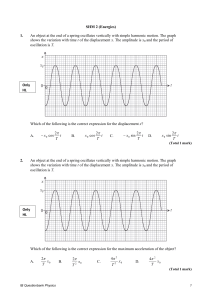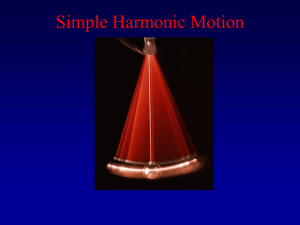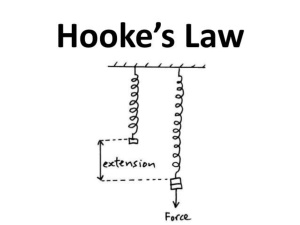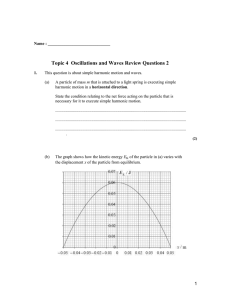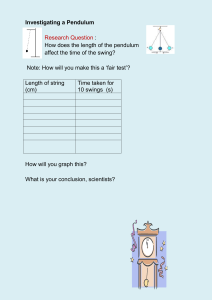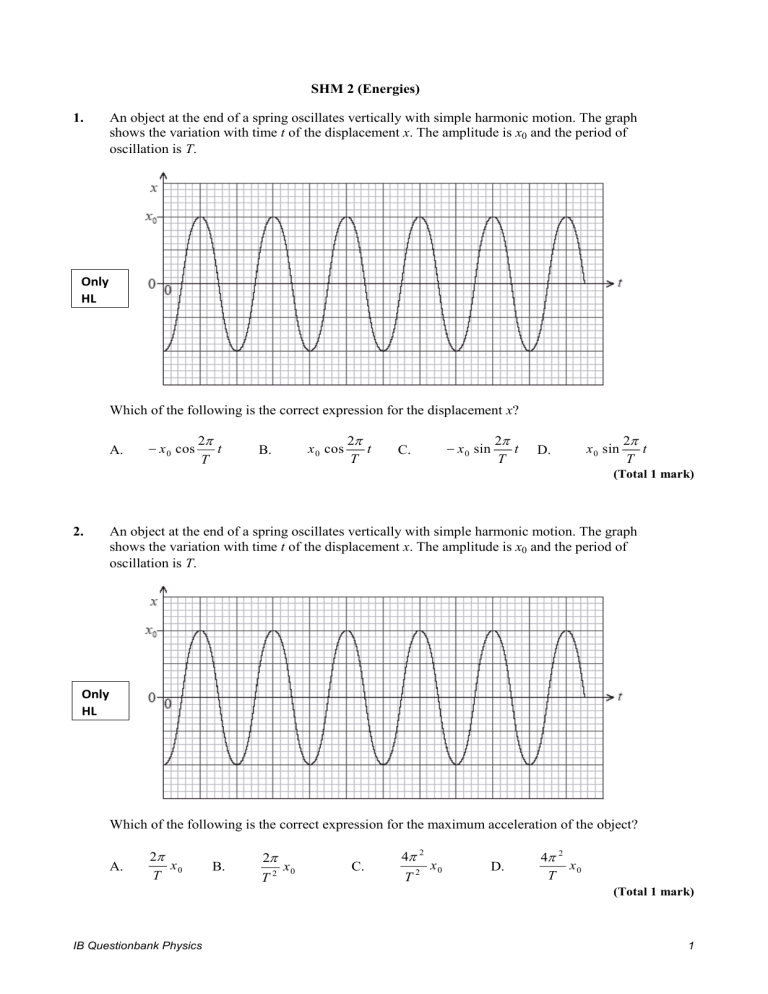
SHM 2 (Energies) 1. An object at the end of a spring oscillates vertically with simple harmonic motion. The graph shows the variation with time t of the displacement x. The amplitude is x0 and the period of oscillation is T. Only HL Which of the following is the correct expression for the displacement x? A. x 0 cos 2 t T x 0 cos B. 2 t T x 0 sin C. 2 t T D. x 0 sin 2 t T (Total 1 mark) 2. An object at the end of a spring oscillates vertically with simple harmonic motion. The graph shows the variation with time t of the displacement x. The amplitude is x0 and the period of oscillation is T. Only HL Which of the following is the correct expression for the maximum acceleration of the object? A. 2 x0 T B. 2 T2 x0 C. 4 2 T2 x0 D. 4 2 x0 T (Total 1 mark) IB Questionbank Physics 1 3. A particle oscillates with simple harmonic motion with period T. At time t = 0, the particle has its maximum displacement. Which graph shows the variation with time t of the kinetic energy Ek of the particle? (Total 1 mark) 4. A mass on the end of a horizontal spring is displaced from its equilibrium position by a distance A and released. Its subsequent oscillations have total energy E and time period T. Only HL An identical mass is attached to an identical spring. The maximum displacement is 2A. Assuming this spring obeys Hooke’s law, which of the following gives the correct time period and total energy? New time period New energy A. T 4E B. T 2E C. 2T 4E D. 2T 2E (Total 1 mark) IB Questionbank Physics 2 5. This question is about simple harmonic motion and waves. (a) A particle of mass m that is attached to a light spring is executing simple harmonic motion in a horizontal direction. State the condition relating to the net force acting on the particle that is necessary for it to execute simple harmonic motion. ...................................................................................................................................... ...................................................................................................................................... ...................................................................................................................................... (2) (b) The graph shows how the kinetic energy EK of the particle in (a) varies with the displacement x of the particle from equilibrium. (i) Using the axes above, sketch a graph to show how the potential energy of the particle varies with the displacement x. (2) (ii) Only HL The mass of the particle is 0.30 kg. Use data from the graph to show that the frequency f of oscillation of the particle is 2.0 Hz. ........................................................................................................................... ........................................................................................................................... ........................................................................................................................... IB Questionbank Physics 3 ........................................................................................................................... ........................................................................................................................... ........................................................................................................................... (4) (c) The particles of a medium M1 through which a transverse wave is travelling, oscillate with the same frequency and amplitude as that of the particle in (b). Answer after 4.2 (i) travelling waves Describe, with reference to the propagation of energy through the medium, what is meant by a transverse wave. ........................................................................................................................... ........................................................................................................................... ........................................................................................................................... ........................................................................................................................... (2) Answer after 4.2 travelling waves (ii) The speed of the wave is 0.80 m s–1. Calculate the wavelength of the wave. ........................................................................................................................... ........................................................................................................................... (1) (Total 11 marks) 6. This question is about oscillations and waves. (a) A rectangular piece of wood of length l floats in water with its axis vertical as shown in diagram 1. The length of wood below the surface is d. The wood is pushed vertically downwards a distance A such that a length of wood is still above the water surface as shown in diagram IB Questionbank Physics 4 2. The wood is then released and oscillates vertically. At the instant shown in diagram 3, the wood is moving downwards and the length of wood beneath the surface is d + x. (i) On diagram 3, draw an arrow to show the direction of the acceleration of the wood. (1) (ii) The acceleration a of the wood (in m s–2) is related to x (in m) by the following equation. a= 14 x l Explain why this equation shows that the wood is executing simple harmonic motion. ........................................................................................................................... ........................................................................................................................... ........................................................................................................................... ........................................................................................................................... (2) (iii) The period of oscillation of the wood is 1.4 s. Show that the length l of the wood is 0.70 m. ........................................................................................................................... ........................................................................................................................... Only HL ........................................................................................................................... ........................................................................................................................... ........................................................................................................................... (3) (b) The wood in (a), as shown in diagram 2, is released at time t = 0. On the axes below, sketch a graph to show how the velocity v of the wood varies with time over one period of oscillation. IB Questionbank Physics 5 (1) (c) The distance A that the wood is initially pushed down is 0.12 m. (i) Calculate the magnitude of the maximum acceleration of the wood. ........................................................................................................................... Only HL ........................................................................................................................... ........................................................................................................................... ........................................................................................................................... (2) (ii) On your sketch graph in (b) label with the letter P one point where the magnitude of the acceleration is a maximum. (1) (d) The oscillations of the wood generate waves in the water of wavelength 0.45 m. The graph shows how the displacement D, of the water surface at a particular distance from the wood varies with time t. IB Questionbank Physics 6 Using the graph, calculate the (i) Answer after 4.2 travelling waves speed of the waves. ........................................................................................................................... ........................................................................................................................... ........................................................................................................................... ........................................................................................................................... (2) (ii) ratio of the displacement at t = 1.75 s to the displacement at t = 0.35 s. ........................................................................................................................... ........................................................................................................................... ........................................................................................................................... ........................................................................................................................... (2) (iii) ratio of the energy of the wave at t = 1.75 s to the energy at t = 0.35 s Only HL ........................................................................................................................... ........................................................................................................................... (1) (Total 15 marks) 7. This question is about a simple pendulum. (a) A pendulum consists of a bob suspended by a light inextensible string from a rigid support. The pendulum bob is moved to one side and then released. The sketch graph shows how the displacement of the pendulum bob undergoing simple harmonic motion varies with time over one time period. IB Questionbank Physics 7 On the sketch graph above, (i) label with the letter A a point at which the acceleration of the pendulum bob is a maximum. (1) (ii) label with the letter V a point at which the speed of the pendulum bob is a maximum. (1) (b) Explain why the magnitude of the tension in the string at the midpoint of the oscillation is greater than the weight of the pendulum bob. ...................................................................................................................................... ...................................................................................................................................... ...................................................................................................................................... ...................................................................................................................................... ...................................................................................................................................... (3) (c) The pendulum bob is moved to one side until its centre is 25 mm above its rest position and then released. (i) Show that the speed of the pendulum bob at the midpoint of the oscillation is 0.70 m s–1. ........................................................................................................................... ........................................................................................................................... ........................................................................................................................... ........................................................................................................................... IB Questionbank Physics 8 (2) (ii) The mass of the pendulum bob is 0.057 kg. The centre of the pendulum bob is 0.80 m below the support. Calculate the magnitude of the tension in the string when the pendulum bob is vertically below the point of suspension. ........................................................................................................................... ........................................................................................................................... ........................................................................................................................... ........................................................................................................................... ........................................................................................................................... (3) (Total 10 marks) IB Questionbank Physics 9
